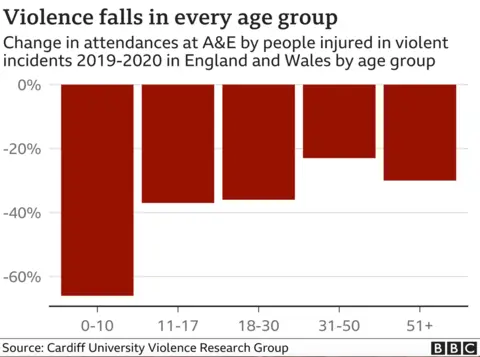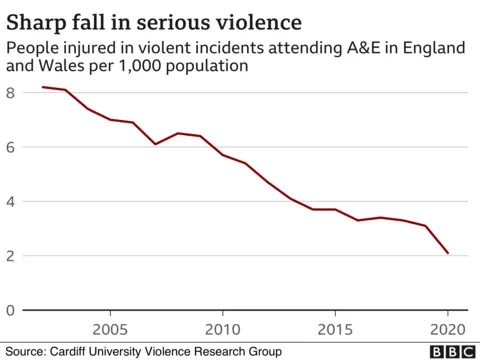Violent crime falls sharply during Covid lockdown - study
 Getty Images
Getty ImagesCovid-19 restrictions led to the sharpest fall in violent crime for at least 20 years, a report suggests.
Violence was down by a third in England and Wales in 2020 compared with the previous year, according to research by Cardiff University.
"From a violence perspective, 2020 was the safest year on record," said co-author Prof Jonathan Shepherd.
But the report also found that the easing of restrictions was "accompanied by rapid increases" in violence.
Cardiff University's Violence Research Group analysed data for the whole of 2020 from 133 NHS hospital emergency departments, minor-injury units and walk-in centres, across England and Wales.
The number of people who attended for treatment of violence-related injuries in 2020 was 119,111 - 56,653 fewer than in the previous year.
The reductions were across all age groups but were most marked among children under the age of 11, where violence levels were down by 66%.

The report concluded that this was "likely to reflect the unprecedented restrictions imposed on free movement of citizens and businesses to limit the spread of the Covid-19 pandemic".
When restrictions were eased in May 2020 to include the phased re-opening of pubs and bars, violence rose again, and by August it had reached pre-pandemic levels.
During the second lockdown in the autumn, which included a 22:00 curfew, there was another sharp fall in the number of people needing hospital treatment for injuries.
The data highlights a clear link between violence and late-night drinking.
"Efforts to prevent serious violence should be concentrated in night-time economies where pubs, clubs and other licensed premises are located," says the report.
Another encouraging conclusion is that there has been a gradual reduction in serious violence over most of the past 20 years.

This is because of "advances in inter-agency collaboration, data sharing and analysis, targeted policing and real-time CCTV surveillance," said Prof Shepherd.
"These factors are all vulnerable when the economy is stretched; they need constant attention."
But while the figures are clearly welcome, they do not tell the whole picture.
Homicide in England and Wales has been rising since 2015, as has knife crime.
Also, not all violence ends with a visit to hospital.
Statistics for the year ending March 2020 revealed that fewer than half of all violent incidents resulted in physical injury.
Domestic abuse
The effects of lockdown on domestic violence are still unclear because few of the hospitals in this survey were able to provide information on the location of violence.
Data from Cardiff A&E shows levels of violence in the home in the city were unchanged in 2020.
However, other figures have shown an increase in demand for domestic abuse services across England and Wales.
A 10% rise in domestic violence-related offences was recorded by the police in the year ending September 2020, which may reflect improved levels of police recording.
The picture is further complicated because a large number of domestic offences are never reported.
On Thursday the Office of National Statistics will publish annual figures on crime patterns, which will shed more light on what happened to violence during the pandemic.
